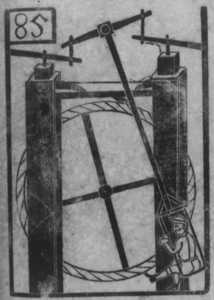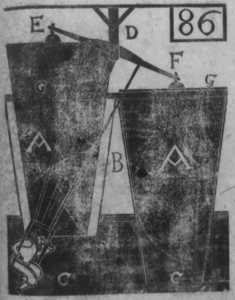Bessler, talking about his wheel wrote:I'd like, at this point, to give a brief description of it. So then, a work of this kind of craftsmanship has, as its basis of motion, many separate pieces of lead. These come in pairs, such that, as one of them takes up an outer position, the other takes up a position nearer the axle. Later, they swap places, and so they go on and on changing places all the time.
Notice the difference between Bessler's description of the weight movement and Wagner's description. Bessler talks of weights moving in and out. Wagner's description, according to Bessler, is of weights gravitating to the center then climbing back up. This is the only time Bessler mentions gravity, and he is simply repeating what Wagner talked about.Bessler, talking about Wagner's wheel description wrote:(This principle is in fact the one that Wagner said he owed to me - but I was quite wrongly implicated, as I'd never informed anyone about the matter.)
At present, as far as I'm concerned, anyone who wants can go on about the wonderful doings of these weights, alternately gravitating to the centre and climbing back up again, for I can't put the matter more clearly.
Bessler said that as far as he was concerned, anyone can go on (discuss) the doings of these weights (as described by Wagner). Bessler says he could not make the matter clearer.
The reason was that if Bessler made the matter clearer he would need to disclose how his wheel worked. So he let people believe what Wagner said. If they wanted to listen to Wagner and ignore what Bessler said, then so be it. They can go on about how they think the weights move.
So let me put this very clear. Bessler said the weights move in and out. One weight moved in and one moved out, then they swap, and on and on they go. Wagner said the the weights gravitate to the center then climb back up again.
Here I think Bessler is mocking Wagner, saying anyone would be really great if they could make a lighter weight cause a heavier weight to rise. Bessler knew that rising and falling weights would only turn a wheel if you could make a light weight cause a heavy weight to rise. He said if you could do that then you would be a really great craftsman.Bessler wrote:But I would just like to add this friendly little note of caution:
- A great craftsman would be that man who can "lightly" cause a heavy weight to fly upwards! Who can make a pound-weight rise as 4 ounces fall, or 4 pounds rise as 16 ounces fall. If he can sort that out, the motion will perpetuate itself. But if he can't, then his hard work shall be all in vain.
This is one of the most informative messages that Bessler gives us. Bessler is saying that trying to add weights here and there so as to cause a wheel to rotate will only make the wheel heavier.Bessler wrote:He can rack his brains and work his fingers to the bones with all sorts of ingenious ideas about adding extra weights here and there. The only result will be that his wheel will get heavier and heavier - it would run longer if it were empty! Have you ever seen a crowd of starlings squabbling angrily over the crumbs on a stationary mill-wheel? That's what it would be like for such a fellow and his invention, as I know only too well from my own recent experience!
The reason was that Bessler's wheel wasn't turned by the heaviness of out-of-balance weights. Bessler said that the weights gained force from moving. He never said his wheel was turned by gravity. He simply let people think what they might, and thus their erroneous thinking has kept his principle a secret for 300 years now.





